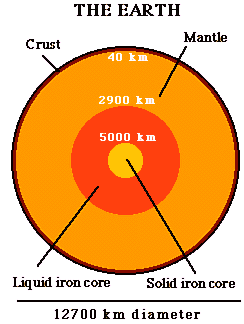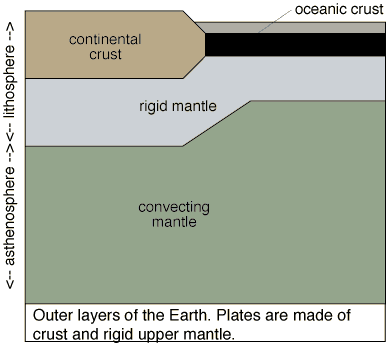| Palaeos: |  |
Geosphere |
| THE EARTH | Structure of the Earth |
| Palaeos: |  |
Geosphere |
| THE EARTH | Structure of the Earth |
| Home | Geosphere | Geology | Structure of the Earth | Plate Tectonics | Palaeogeography | Glossary |
In Geosphere is the solid or mineral part of the Earth, consists of layers, from the outer crust down to the inner core, which have separated through density and temperature. Although it is impossible at present to sample the inner layers of the geosphere, indirect evidence is gained through studying the way earthquake waves pass through or are deflected in their passage through the earth.
There are two ways to classify the composition of the geosphere - chemically, into crust, mantle, and core, or functionally, in the case of the outer layers (crust and mantle) into lithosphere and asthenosphere.
Crust
The outermost layer of the geosphere is called the crust,
which is equivalent to the skin of an apple in thickness relative to the
entire earth. Yet this thin tiny layer is what we think of as "the earth",
with it's mountains, valleys, continents, ocean beds, etc. The crust
is rich in oxygen, silicon and aluminium, with lesser amounts of other
elements like iron. Owing to its low density (2.5 to 3.5 gm/cm3),
the crust is able to float on the denser mantle. The Earth's crust,
as with many planetary crusts, is brittle and breaks relatively easily.
There are actually two types of crust, continental and oceanic.
Continental crust is made up of volcanic lava flows, huge granite blocks, and sediments laid down in shallow water or continental seas. It is quite thick, averaging 30 to 40 km and beneath parts of mountain ranges reaching 80 km. But it is made of lower density rocks, such as andesite and granite.
Oceanic crust is thin, only about 5 to 10 km deep, and made of relatively dense rock called basalt, possibly underlain by gabbro (a similar but coarser grained rock). It also contains a greater proportion of magnesium. The composition of the lower crust is not known, but it is probably gabbro. Seismic waves pass through it at a more rapid rate than they do the upper crust.
Mantle
Beneath the crust is a complex middle region known as the mantle.
It is a broad layer of dense rock and metal oxides that lies between the
molten core and the crust. The mantle extends to a depth of about
2900 km and accounts for around 82% of the Earth's volume. The mantle
is thought to be made up mostly of peridotite,
a type of rock composed of iron, magnesium, silicon, and oxygen.
Analysis of seismic waves show that the material that makes up the
mantle behaves as a plastic - a substance
with the properties of a solid but flows under pressure. More precisely,
the mantle consists of rigid and plastic zones. The density of the
mantle ranges from 3.5 to 5.8 gm/cm3.
Core
The core is composed of mostly iron and nickel and remains very hot,
even after 4.5 billion years of cooling. Estimates of temperature are about
7000K (equal to the surface of a red dwarf), and having a density of around
14 gm/cm3. The core is divided into two layers: the liquid
outer core and - at the Earth's center - the solid iron inner core.
Despite the tremendous temperatures this layer is solid due to the immense
pressure of the overlying layers. The inner core's radius is about
22% that of the overall Earth.
The sharp boundary between the crust and mantle is called the Mohorovičić discontinuity or Moho. While the Gutenberg discontinuity seperates the mantle from the core.
Here is a diagram of the Geosphere according to the division of crust, mantle, and core:

Here is a diagram of the outer part of the Geosphere according to the Lithosphere and Asthenosphere:

this diagram is from VolcanoWorld

Plate Tectonics |

Palaeogeography |
plate tectonics and continental drift icons from This Dynamic Earth:The Story of Plate Tectonics, by W. Jaquelyne Kious and Robert I. Tilling, (on-line edition)